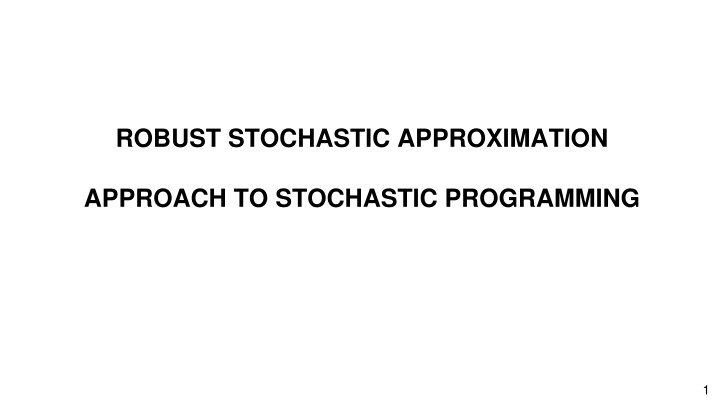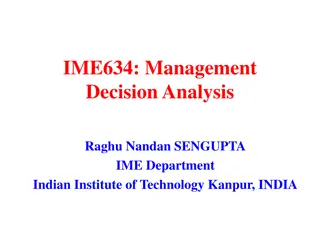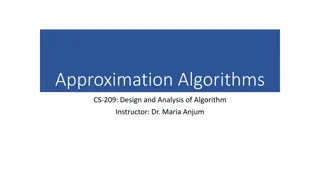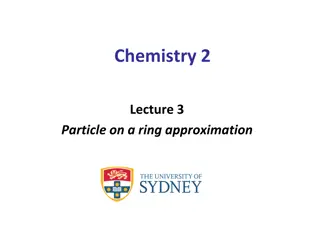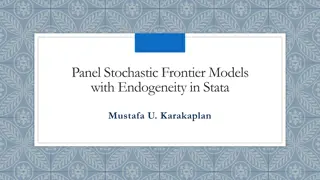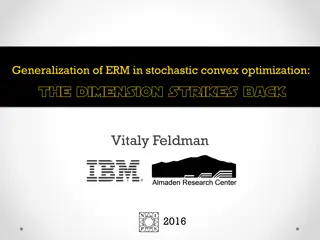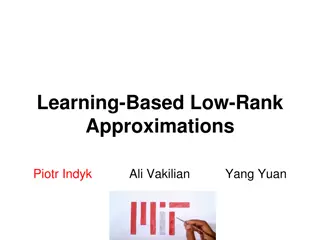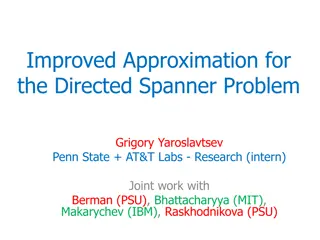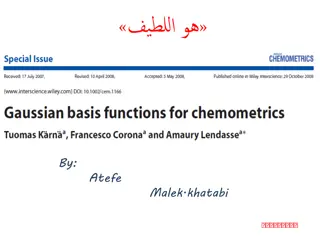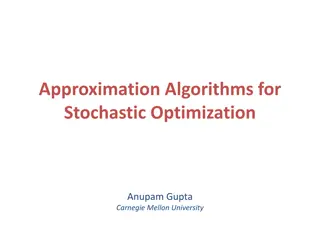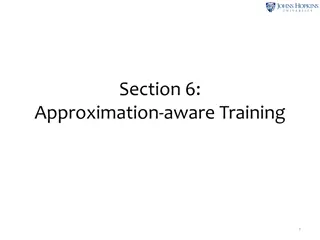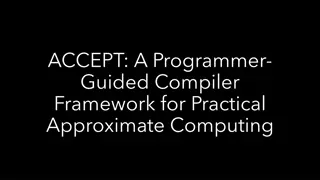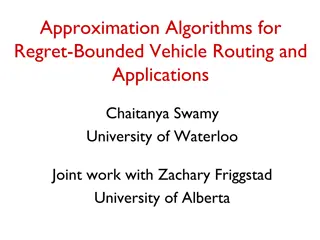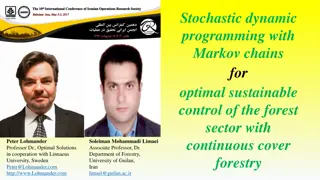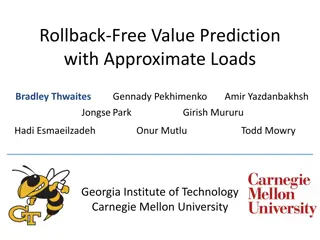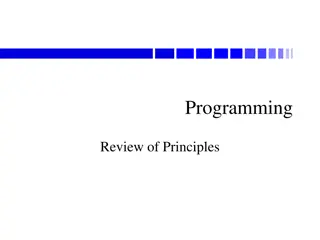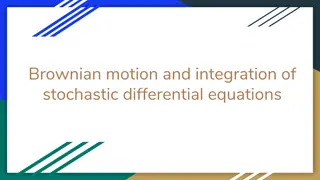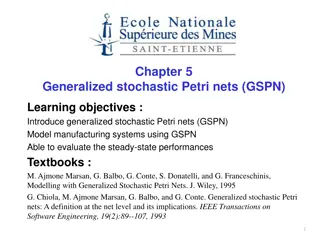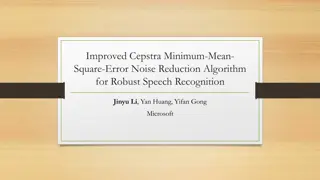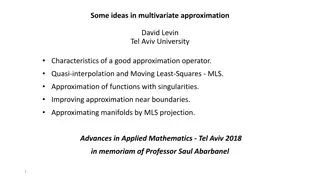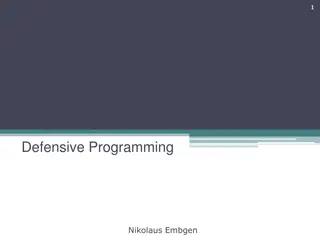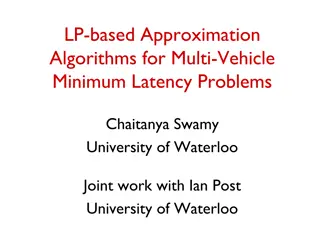ROBUST STOCHASTIC APPROXIMATION APPROACH TO STOCHASTIC PROGRAMMING
Discussed are stochastic optimization problems, including convex-concave saddle point problems. Solutions like stochastic approximation and sample average approximation are analyzed. Theoretical assumptions and notations are explained, along with classical SA algorithms. Further discussions delve into differentiability and strong convexity of functions in X.
Download Presentation

Please find below an Image/Link to download the presentation.
The content on the website is provided AS IS for your information and personal use only. It may not be sold, licensed, or shared on other websites without obtaining consent from the author.If you encounter any issues during the download, it is possible that the publisher has removed the file from their server.
You are allowed to download the files provided on this website for personal or commercial use, subject to the condition that they are used lawfully. All files are the property of their respective owners.
The content on the website is provided AS IS for your information and personal use only. It may not be sold, licensed, or shared on other websites without obtaining consent from the author.
E N D
Presentation Transcript
ROBUST STOCHASTIC APPROXIMATION APPROACH TO STOCHASTIC PROGRAMMING 1
Two problems discussed: 1. stochastic optimization problem: 1. convex-concave stochastic saddle point problems 2
stochastic optimization problem: x is a n dimension vector X is a n dimension nonempty bounded closed convext set (x s domain) is a d dimension random vector is a d dimension vector set, s probabilty distribution P is supported on support : P( ) > 0 F: X -> R Assume: the expected value function f(x) is continuous and convex on X not necessarily differentiable Convex Non-Convex Non-differentiable at x0 3
Solutions to the stochastic optimization problem: the stochastic approximation (SA) the sample average approximation (SAA) people think SAA is better than SA the proposed modified SA is competitive with SAA Two assumptions: possible to generate an independent identically distributed sample(iid sample) 1, 2,..., of an oracle existed: for a input point (x, ) X returns G(x, ) such that g(x) := E[G(x, )] f(x) subgradient of f(x) 4
Notations ||x||pdenotes lpnorm ||x||2 is the euclidean distance; ||x|| = max{|x1|,..., |xn|} X : the metric projection operator onto the set X [j 1]= ( 1,..., j 1) : the history of the generated random process 5
SA Approach 1, Classical SA algorithm: for chosen x1 X and a sequence stepsize j> 0, j = 1,... iterate like this: solved by an oracle problem left: decide stepsize j ; note: x*is the optimal x, Aj= 0.5|| xj x ||22, aj = E[Aj] = 0.5E[|| xj x ||22] . xj+1 x* X (a-b)2= a2-2ab+b2 ; a=(xj-x*) with M > 0, we get: and assume 6
Further assume: f(x) is differentiable and strongly convex on X, we have: there is constant c > 0 such that strong convexity of f(x) implies that the minimizer x is unique, then we have: then we have 7
With we have (x x )Tg c||x x ||22for all x X and g f(x), follew by combine with we have: 8
Back to the problem : decide the stepsize decide stepsize j Strategy: take stepsizes j= /j for some constant > 1/(2c) based on , we have: expectation of distance square Conclusion: after j iterations, converge rate in term of the distance to x is O(j 1/2) 9
Futher assume: x is an interior point of X f(x) is Lipschitz continuous, i.e., Conclusion: after j iterations, converge rate in term of objective value is O(j 1) 10
Observation: 1) the convegence speed is highly sensitive to a priori information on c E.g. consider f(x) = x2/10, X = [ 1, 1] R, and G(x, ) f(x). We start at point x1= 1, and set = 1/c Case 1: overestimated c, by taking = 1 (i.e., j= 1/j) -> c=1 after j = 109 iterations, xj>0.015 (optimal x*=0) Case 2: lucky choice c=0.2, by taking = 5 (i.e., j= 5/j) . then xj+1= (1 - 1/j)xj x2=0=x*, converge after first iteration 2) the stepsizes j= /j may become completely unacceptable when f loses strong convexity. E.g. consider f(x) = x4, X = [ 1, 1] R, and G(x, ) f(x). with j= /j and 0 < x1 1 /(6 ) i.e. 11
SA Approach 2, Robust SA approach (different stepsize strategy): Assume convexity, we have: 12
Using a fixed stepsize: Assume: the number N of iterations of the method is fixed in advance t = > 0, t = 1,...,N. minimize the right-hand side of we get: We also have, for 1<= K <= N Assume constant stepsize with parameter a constant > 0 , i.e. 13
Based on Robust SA s expected error in term of the objective value is O(N-1/2), which is worse than the classic SA (O(N-1)) Roubust SA only assumes convexity the classic SA assumes: smooth strongly convex function with domain which contains the minimum point x* For Robust SA, no need to tune a fine stepsize (so called robust) 14
Using varying stepsizes: Assume: the number N of iterations of the method is not fixed using stepsize We have, for 1<= K <= N setting K = rN , with a fixed r (0,1), 15
Mirror descent SA (general lp norm): Notation: refer to the 2.2 Robust Euclidean SA as E-SA be a (general) norm on Rn a function : X R is a distance-generating function modulus > 0 with respect to > ( is the f(x) in previous sections) with assumptions: is continously differentiabl and strongly convex with parameter with respect to , i.e. -> a linear function space - where with similar deduction, we get: 16
begin from formula 2.41, assume that the method starts with the minimizer of deduct further, we get: Using a constant stepsize: assuming the number N of iterations of the method is fixed in advance t = > 0, t = 1,...,N. assume a constant parameter ? > 0, and the stepsize is 17
Analysis of deviations assume a stronger inequation: comparing to 18
Using varying stepsize With similar deduction, we get, for 1<= K <= N, minimize the right-hand side, we get a decreasing stepsize policy 19
Comparison between E-SA and M-SA - the same convegence speed: O(N-1/2) in terms of the expected error of the objective For E-SA, For M-SA(l1norm), Get a ratio: Conclusion: under the example s setting, l1never is much worse than the l2, b/c on the left-hand side, the ratio is related to l1could ne far better than l2, b/c on the right-hand side, the ratio is related to n 20
Comparison between M-SA and SSA - compare the required iteration numbers for M-SA and the required smaple size of SSA to reach Conclusions: both SA and SAA methods have logarithmic in and quadratic (or nearly so) in 1/ complexity in terms of the corresponding sample sizes. the SAA method requires solution of the corresponding (deterministic) problem the SA approach is based on simple calculations as long as stochastic subgradients could be easily computed 21
Stochastic saddle point problem : similar assumptions. Mirror SA algorithm for saddle point problems - with similar assumptions and deduction, we get: for constant stepsize approach: For a fixed number of steps N,with the constant stepsize policy for variable stepsize: , we have: 22
deviration analysis for varying stepsize assume : we have: 23
Application to minimax stochastic problems Considering problem: assume : the expected value functions fi( ), i = 1,...,m, are well defined, finite valued, convex, and Lipschitz continuous on X and similar other assumptions. Then the problem equal to: Using the constant stepsize policy, we get: Conclusion: The error of the saddle point mirror SA algorithm in this case is almost independent of the number m of constraints (it grows as O( lnm) as m increases) 24
Finally, lets talk about the oracle: In order to obtain a realization G(x, y, ),one has to compute m random subgradients Gi(x, ), i = 1, . . . , m, and then their convex combination The minimax stochastic problem can be treat as a stochastic descending problem with a randomized oracle 25
Application to bilinear matrix games distance function: already know: using randomized oracle: for expected error analysis: for deviation analysis: 26
we have error bound after N iterations: the total number of entries in A used in the course of the entire computation does not exceed 27
Conclusion 1. It introduces the Classic SA approach of solving stochastic optimization problem, and proves its objective function f(x) s converge rate is O(t-1), here t is iteration times. 1. It proposes a new Robust SA approach using Euclidean distance(l2norm) as its distance measure. Its converge rate is also O(t-1). Howerver it has a more subtle way to decide stepsize comparing to the Classic SA, which doesn t require tuning. 1. It proposes the Mirror descent SA which generalizes the Robust SA to lpnorm. Note: the above three appoaches all require an oracle to provide sub-gradient. It applies the Mirror descent SA approach to a new problem: saddle point problem. In this problem, it demostrate a way to implement the oracle. 4. 28
Q&A Yifang: 1. The first paper says Equation (5) is the Taylor expansion of batching learning. But I feel that it is both batch learning and online learning. Is it correct? 2. What does E in equation (6) of the first paper denote? 3. What is sub-gradient, defined on the page 1575 of the second paper? for any x0in the domain of the function one can draw a line which goes through the point (x0, f(x0)) and which is everywhere either touching or below the graph of f. The slope of such a line is called a subderivative (used for undifferemtiable points, not smooth lines) 29
Q&A Tavish: From Large Scale Online Learning paper: 1. What is the difference between optimization and learning speed with respect to empirical cost C_n and expected cost C_{\infinity}? 2. Also, paper mentions that both batch and online sequences converge at the same speed for adequate choices of scaling matrix. Does it mean that both are equally fast? How does convergence speed relate to learning/optimization speed? From ROBUST STOCHASTIC APPROXIMATION APPROACH TO STOCHASTIC PROGRAMMING: 3. I didn t understand much of this paper. So to just get a high level idea of what is the gist behind the two methods that have been compared in the paper, can you briefly describe the stochastic approximation (SA) and the sample average approximation (SAA) method and highlight the major difference between the two? In the classical analysis of the SA algorithm assumed that f( ) is twice continuously differentiable f( ) is strongly convex the minimizer of f belongs to the interior of X conclusions for SA: rate of convergence E[f(xt) f ] = O(t 1) sensitive to a choice of the respective stepsizes longer stepsizes were suggested with consequent averaging of the obtained iterates For convex-concave saddle point problems, if assume: general-type Lipschitz continuous convex objectives conclusions for saddle point problems: O(t 1/2) rate of convergence This paper doesn t focus on the SAA approach. Briefly, the SAA approach generate a (random) sample 1,..., N , of size N, and approximate the true problem (1.1) by the sample average problem 30
Q&A Brad: 1. re: Large Scale Online Learning - Is there any way to quantify the point where online algorithms become better? i.e. in terms of dataset size. 2. re: Stockastic Approzximation - Can you give an overview of the "Classical SA algorithm?" problems: try to solve , and find the optimal x solution: gradient descent, using iteration formular: in jthiteration, find a sub-gradient descending direction, and move rjstep size. rjis setted as j= /j 3. re: Stochastic Approximation - Does E-SA ever outperform N-SA in terms of quality of solutions? Yes. E-SA and N-SA s performace ratio satisfy this inequation: both equal signs can be meet 31
Q&A Yuankai: Questions for Stochastic Gradient Descent: 1. What is the contribution and importance of this paper? 2. As the paper argues that "an adequate online algorithm outperforms any batch algorithm during the final convergence phase as well , so are there any situations that batch algorithm works better? 3. What is saddle point problem and stochastic saddle point problem? stochastic saddle point problem: saddle point problem is in the similar form but without random variable 32
Brendan: From "Large Scale Online Learning", 1. I'm having trouble understanding the scaling matrix Phi_k. It doesn't appear to allow much flexibility in the step-size since it's real-valued? The authors mention "single sweep" as a major advantage of the online algorithm (the idea being that going to disk for the same piece of data repeatedly could get extremely costly), but how would a batch chosen to fit in main memory compare with an online algorithm given the same amount of runtime and how would the comparison change with scale? From "Robust Stochastic Approximation Approach to Stochastic Programming", 1. Does "robust" refer strictly to the strongly convex vs. convex assumption? The results seem a little suspect since they chose a specific problem class and tailored the SA approach while using a general SAA-based algorithm. 2. No. Robust doesn t mean convex assumption. It means this approach doesn t need to tune stepsize. It has a formula to decide the stepsize. 33
Grace: 1) What is positive definite. What is positive semi-definite. What is mini-max. 2) bottou and Cun. When you do online gradient, whether the order of using which sample to process at time t matters? Will different order in the same batch will have different results? Does it matter? 3) For nemirovski et al., algorithms in 2.1, 2.2, 2.3, what are their differences? Show in details. Be concise. 1. It introduces the Classic SA approach of solving stochastic optimization problem, and proves its objective function f(x) s converge rate is O(t- 1), here t is iteration times. 2. It proposes a new Robust SA approach using Euclidean distance(l2norm) as its distance measure. Its converge rate is also O(t-1). Howerver it has a more subtle way to decide stepsize comparing to the Classic SA, which doesn t require tuning. 3. It proposes the Mirror descent SA which generalizes the Robust SA to lpnorm. 4) nemirovski et al.. Can you find a demo for one algorithm in section 2, as well as one algorithm in section 3? otherwise, show graphical illustrations for them to illustrate the idea. Online demo will be the best. E.g. consider f(x) = x2/10, X = [ 1, 1] R, and G(x, ) f(x). We start at point x1= 1, and set = 1/c Case 1: overestimated c, by taking = 1 (i.e., j= 1/j) -> c=1 after j = 109 iterations, xj>0.015 (optimal x*=0) Case 2: lucky choice c=0.2, by taking = 5 (i.e., j= 5/j) . then xj+1= (1 - 1/j)xj x2=0=x*, converge after first iteration 34
stochastic optimization problem: x is a n dimension vector (is x a vector of random variables?) X is a n dimension nonempty bounded closed convext set (x s domain) is a d dimension random vector is a d dimension vector set, s probabilty distribution P is supported on F: X -> R ps: - the support of a function is the set of points where the function is not zero-valued - Let S be a vector space over the real numbers, or, more generally, some ordered field. This includes Euclidean spaces. A set C in S is said to be convex if, for all x and y in C and all t in the interval [0, 1], the point (1 t)x + ty also belongs to C -Close set: For a set closed under an operation - A set S is bounded if it has both upper and lower bounds 36
stochastic subgradient for any x0in the domain of the function one can draw a line which goes through the point (x0, f(x0)) and which is everywhere either touching or below the graph of f. The slope of such a line is called a subderivative (used for undifferemtiable points, not smooth lines) 37
Previous Work In the classical analysis of the SA algorithm assumed that f( ) is twice continuously differentiable f( ) is strongly convex the minimizer of f belongs to the interior of X conclusions for SA: rate of convergence E[f(xt) f ] = O(t 1) sensitive to a choice of the respective stepsizes longer stepsizes were suggested with consequent averaging of the obtained iterates For convex-concave saddle point problems, if assume: general-type Lipschitz continuous convex objectives conclusions for saddle point problems: O(t 1/2) rate of convergence 38
Previous Work The SAA approach generate a (random) sample 1,..., N , of size N, and approximate the true problem (1.1) by the sample average problem 39
Compactness Compactness: In mathematics, and more specifically in general topology, compactness is a property that generalizes the notion of a subset of Euclidean space being closed (that is, containing all its limit points) and bounded (that is, having all its points lie within some fixed distance of each other). 41
